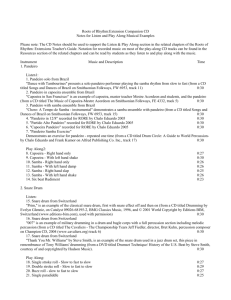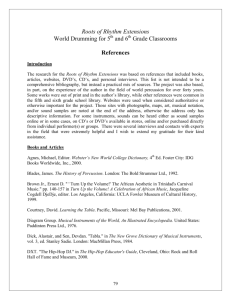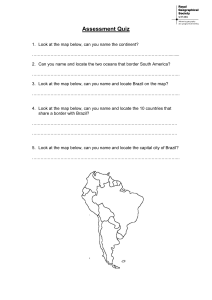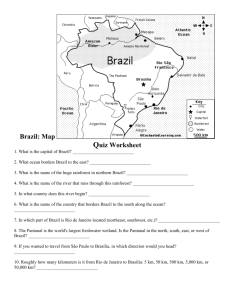Pandeiro, a Carnival tambourine Country: Brazil
advertisement
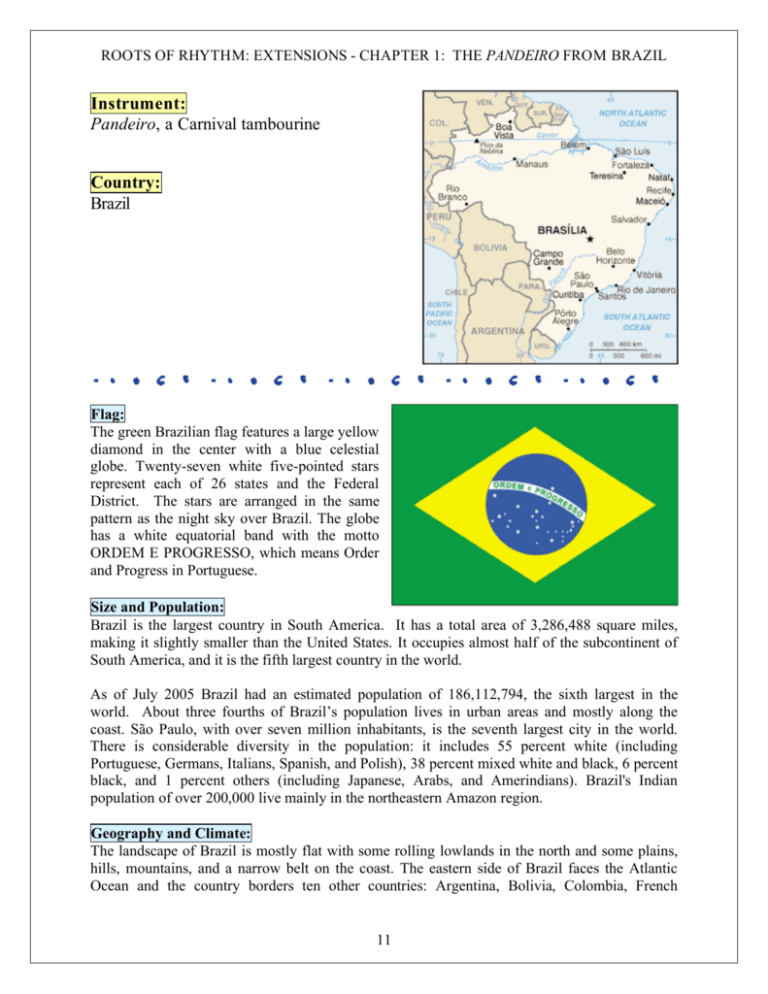
ROOTS OF RHYTHM: EXTENSIONS - CHAPTER 1: THE PANDEIRO FROM BRAZIL Instrument: Pandeiro, a Carnival tambourine Country: Brazil Flag: The green Brazilian flag features a large yellow diamond in the center with a blue celestial globe. Twenty-seven white five-pointed stars represent each of 26 states and the Federal District. The stars are arranged in the same pattern as the night sky over Brazil. The globe has a white equatorial band with the motto ORDEM E PROGRESSO, which means Order and Progress in Portuguese. Size and Population: Brazil is the largest country in South America. It has a total area of 3,286,488 square miles, making it slightly smaller than the United States. It occupies almost half of the subcontinent of South America, and it is the fifth largest country in the world. As of July 2005 Brazil had an estimated population of 186,112,794, the sixth largest in the world. About three fourths of Brazil’s population lives in urban areas and mostly along the coast. São Paulo, with over seven million inhabitants, is the seventh largest city in the world. There is considerable diversity in the population: it includes 55 percent white (including Portuguese, Germans, Italians, Spanish, and Polish), 38 percent mixed white and black, 6 percent black, and 1 percent others (including Japanese, Arabs, and Amerindians). Brazil's Indian population of over 200,000 live mainly in the northeastern Amazon region. Geography and Climate: The landscape of Brazil is mostly flat with some rolling lowlands in the north and some plains, hills, mountains, and a narrow belt on the coast. The eastern side of Brazil faces the Atlantic Ocean and the country borders ten other countries: Argentina, Bolivia, Colombia, French 11 ROOTS OF RHYTHM: EXTENSIONS - CHAPTER 1: THE PANDEIRO FROM BRAZIL Guiana, Guyana, Paraguay, Peru, Suriname, Uruguay, and Venezuela. Brazil has the world’s largest rainforest, which covers most of the north and includes the enormous Amazon River that winds through the humid jungle. There are over 1000 rivers in Brazil. Mountains rise north of the forests and in the southeast. Across parts of northeastern Brazil there are dry plains, while the low plateaus of southern and central Brazil have fertile farmlands and ample grazing area. Along the Atlantic coast there are wide white beaches. Travel is restricted in the large interior, which remains mostly undeveloped. The climate is mostly tropical, but it is temperate in south. The lowlands are generally warm, the mountains and plateaus are usually cool, and some coastal areas are cooled by sea breezes. Since rain falls heavily across Brazil, the country is one of the world’s largest crop-growing countries. Background and History: When Pedro Álvares Cabral, a Portuguese commander, landed in the area now known as Brazil in 1500, the land was populated by indigenous Indians, including the Guaraní and Tupinamba. After a treaty with Spain, Cabral claimed the area for his country, and thus began three centuries of rule of under Portugal. At that time Brazil was named after certain trees or brazilwoods, because the wood looked like a glowing ember, called brasa in Portuguese. With the arrival of colonists in the 1530s, settlements were established in the northeast and in southern Brazil. At first local Indians were enslaved to work these plantations. But in 1538, African slaves primarily from Angola were brought to replace the Indians who had died or were killed. The infusion of this almost free labor force had a profound influence not only on Brazil’s economic development in the world, but also on its cultural evolution, notably through African influence in music and dance. Though the Dutch invaded Brazil in 1630, they were driven out twenty-four years later. By the end of the seventeenth century, the discovery of diamonds had brought thousands of Portuguese to the interior regions of Brazil and great riches to Portugal. In 1750, Portugal and Spain signed a treaty settling ruling areas in South America. By 1800, there were 3.5 million people in Brazil; half the population was slaves. Beginning in 1808, the Portuguese royal family moved from Portugal to Rio de Janeiro, ruling both countries from Brazil’s capital. In 1822, Brazil won its independence from Portugal. This began a period of great progress including the building of railroads and telegraph communication systems. By the mid-1800s there was a global demand for rubber products and coffee from Brazil. At this time, thousands of immigrants from Germany, Italy, and other European nations began to arrive. When slavery was finally abolished in 1888, nearly 750,000 slaves were freed. In 1889 Brazil became a republic and soon thereafter adopted a constitution. From that time through the 1930s two presidents were elected, but they ruled as dictators. After WWII, Brazil joined the United Nations, wrote a new constitution, and restored individual rights. In order to represent more of the interior of the country, the capital was moved from the coastal city of Rio de Janeiro to the modern inland city of Brasilia in 1960. In 1964, the military took over the government, a change that lasted for over twenty years. This was followed by a peaceful transition back to civilian rule. The largest economic and regional leader in South America, 12 ROOTS OF RHYTHM: EXTENSIONS - CHAPTER 1: THE PANDEIRO FROM BRAZIL Brazil continues to grow as through industrial and agricultural growth and development of its interior. Assisting this is the vast natural resources in its interior and a larger labor pool. Brazil's economy is larger than all other South American countries and it is expanding its markets all over the world. Culture: Brazil shares many traditions with Portugal since it was a Portuguese colony for over 320 years. The Portuguese colonists also brought Roman Catholicism, which is now the dominant religion in the country at around 80 percent. The remaining 20 percent is a mixture of other religions including Lutheran, Jewish, and Buddhist. Today, about 10 percent of Brazilians, mostly those with African heritage, practice macuma (mah-ku-mah) and candomble (con-dome-blay), a combination of African and Catholic spiritual beliefs. While Portuguese is the official language, Spanish, English, and French are also spoken. About 80 percent of Brazil's adults can read and write. Public education is free, but many children in the rural areas leave school after the age of fourteen in order to work. The country's literature, including poems about slavery and the Indian population, has revealed much about its past. Although there is a productive economy, a great difference exists between rich and poor, with a small minority living very well, some living comfortably, but the vast majority living under very poor conditions. Those with European backgrounds often have better educational opportunities and higher paying jobs than other ethnic groups. In spite of these social imbalances, there is much less racial discrimination in Brazil than in other multi-ethnic nations. Brazilians take pride in many aspects of their culture and one important aspect is their music and dance. The focus of this chapter, a tambourine called pandeiro (pon-day-roh), has three important cultural connections: a martial art, Carnival, and current events. The martial art called capoeira (cah-pooh-eh-rah) uses several musical instruments including the pandeiro to accompany the performers. Around four hundred years ago capoeira was brought by slaves from Angola, Africa and became a type of protection against their violent overlords. Disguised and hidden from slave owners as an entertaining non-threatening dance, it was performed with singing and musical instruments. After being outlawed for many years, in 1937, capoeira was legalized by Brazil's president in order to promote it as a Brazilian sport. Around this time the first legally-sanctioned capoeira academy opened in Salvador, Brazil. Today, this martial art is performed internationally both as an expressive remembrance of past harsh times and as an artistic competition sport. Another application of the pandeiro is in the Brazilian samba music used during Carnival. This celebration dates back to Portuguese religious festivals around the time of Lent. After it changed into a masked ball in Rio de Janeiro, it became a procession with floats in 1850. Soon afterward, people paraded in costumes with musicians in large numbers. Samba music evolved out of the music called choro (chaw-roh), a European influenced music in Brazil. The first samba schools, Escolas de Samba (es-koh-las day sahm-bah), started in the late 1920s in Rio de Janeiro. Participants were groups of blacks and others who wanted to make music and then parade during Carnival. They were called schools because performers would practice at a local school. In the 13 ROOTS OF RHYTHM: EXTENSIONS - CHAPTER 1: THE PANDEIRO FROM BRAZIL 1930s the samba rhythm and dance became Brazil's official music. Some samba schools have 4,000 participants and more than 300 percussionists. The pandeiro is also used in rural areas of Brazil as an accompaniment to singers who literally sing the news. The singer collects current events about a village, then moves on to the next village, stands in a central area and sings about the news he or she has collected. In the 1970s transistor radios became more available in areas without electricity, and need for these kinds of musicians diminished. Music: Instruments and Rhythms Instruments: Indigenous people of the Amazon rainforest in Brazil play whistles, flutes, horns, drums, and rattles to maintain the traditions of their ancestors. When the Portuguese arrived in Brazil, missionaries introduced songs in the local Tupi (too-pee) language in order to convert the indigenous people to Christianity. They also brought many types of European instruments including the guitar, clarinet, accordion, and an early type of piano called the clavichord. Other instruments included the Spanish pandero (pon-day-roh), a round frame drum usually with no jingles, as well as the Spanish pandereta (pon-deh-ree-tah) and the Arabic riqq (rick), both tambourines with jingles. The name pandeiro is related to the older Spanish instruments. The adufe brought from Portugal had a major influence on the development of the pandeiro. Many other instruments were brought to Brazil from Africa during the slave trade particularly from Angola. All of these instruments were blended into what became Brazilian instrumental music. Capoeira was practiced with rhythms played on the musical bow, called berimbau (bee-rembow), the agogo (ah-goh-goh), a double bell, the atabaque (ah-tah-bah-keh), a large singleheaded conga drum, and the pandeiro, a single-headed tambourine. The musical instruments used for sambas in Carnival consist of a large ensemble of percussion instruments that included the following: ! agogo, a double bell ! apito (ah-pee-toh), a three-pitched whistle ! repinique (heh-peh-nee-keh), a medium double-headed drum and lead drum ! surdo (sir-doh), a large double-headed bass drum ! rocas (row-kas) or ganzas (ghan-zahs), metal or gourd shakers ! cuica (kwee-kah), a friction drum that can sound like an animal ! timba (tim-bah) a single-headed, cone-shaped drum ! tamborim (tom-bow-reem), a small single-headed frame drum ! pandeiro, a tambourine The pandeiro is a single-headed tambourine with five sets of jingles, with three jingles per set as opposed to the usual two per set. Each set consists of two concave metal discs facing each other with a flat disc in between. The cupped discs have a very high dome, and this along with the flat disc dampens the ring, giving the pandeiro a short low "chuck" sound rather than the usual high ringing "ching" sound of many tambourines. Most pandeiros today have a tunable drumhead made from goat skin, or, more recently, from a thin plastic film like Mylar. These drumheads might be transparent or have colorful designs. The instrument is hit or rubbed with one hand while the other one shakes the jingles and/or dampens the drumhead from underneath. 14 ROOTS OF RHYTHM: EXTENSIONS - CHAPTER 1: THE PANDEIRO FROM BRAZIL Rhythms: The three pandeiro rhythms presented here, capoeira, samba, and six-beat, each require specific combinations of high, medium, and low tones on the drum. High tones involve the slap and jingle shake, medium tones the finger or heel hit, and low tones the thumb stroke. Sometimes it is necessary to combine the motions of both hands, for example, when the left hand dampens the drumhead with a finger while the other hand hits with the thumb to produce a medium tone instead of a low tone. A more advanced technique is the finger or thumb buzz, which is created by lightly pressing the tip of a finger or thumb into the drumhead and moving it in an arch or circles so as to cause friction on the head. In capoeira, the ginga (ging-gah), possibly translated as "swing," was the basic movement invented to disguise the movements as dance instead of a fight practice. The ginga is set to the rhythm of the berimbau and other percussion instruments or bateria (bah-the-ree-ah) to reinforce the idea of dance but mainly to teach a critical element in capoeira, the timing of their moves. Choro rhythms of the 1800s led to the invention of the samba in the late 1800s. The greatest choro musician of all time was perhaps Pixinguinha (1897-1973). He was the first to incorporate percussion instruments into choro and the pandeiro is still the rhythmic base in traditional choro music. Some people call the choro "the musical soul of the Brazilian music." Jorginho do Pandeiro (hor-heen-ho doh pon-day-roh) is one of the most famous choro pandeiro players. This lesson includes examples of the capoeira rhythms (8 counts) and the samba batucada (bahtoo-kah-dah) rhythms (8 counts) on the panderio. While samba rhythms grew out of choro music in the early part of the twentieth century, they have evolved into many types. The type featured here is samba batucada—the driving samba rhythm played during Carnival by large percussion ensembles (see rhythms in Resources below). Listen & Play Along: Note to teachers: if instruments are not readily available, consider having students make their own (a general activity for making drums can be found in the Roots of Rhythm: Extensions Introduction Section, and a specific activity for making a pandeiro is described below) or encourage them to improvise - using everyday items such as buckets, containers, phonebooks, desktops, etc., as instruments. Rhythms can also be created with body percussion including handclapping, foot tapping, finger snapping, etc. Listen to Tracks 1-7 of the Roots of Rhythm: Extensions Companion CD to hear the sound of the pandeiro. Now it’s time to play the pandeiro. You can also use a tambourine or other frame drum to play along with music on the Roots of Rhythm: Extensions Companion CD. Or, if you don’t have these instruments, make your own substitutes (see activity below for making homemade pandeiro). Listen to Tracks 8-14 of the Roots of Rhythm: Extensions Companion CD and play along with the rhythms. To begin, just try to have fun. Read the box notation in the Resources section that shows each of the various rhythms, and begin again with the count and drum sounds. 15 ROOTS OF RHYTHM: EXTENSIONS - CHAPTER 1: THE PANDEIRO FROM BRAZIL Making Your Own Pandeiro: To make your own homemade pandeiro, hammer some holes in the rim of a sturdy pie tin with a nail, open the holes a bit wider with a screw driver, and then fasten some metal washers through the holes with brass paper fasteners. Be sure to hammer flat any rough edges left from making the nail holes. Pandeiro and Performer: Chalo Eduardo Pandeiro Photographs by Craig Woodson. Resources: The Pandeiro, Playing Techniques, and Rhythms The Pandeiro and Playing Techniques The six beginning strokes used in playing the pandeiro (shown in photographs) are as follows: 1. Thumb Stroke – a hit with the thumb that bounces off the drumhead near the rim allowing the tone to ring…………… 2. Fingers stroke – a hit with the finger tips that presses into the drumhead briefly, stopping the tone…... 3. Heel stroke – a hit with the heel of the right hand near the rim of the drum……………………………………………... 4. Slap – a hit near the center of the drumhead with fingers spread apart and left briefly on the drumhead………………………………………. 16 ROOTS OF RHYTHM: EXTENSIONS - CHAPTER 1: THE PANDEIRO FROM BRAZIL 5. Drumhead finger damp – press the middle finger of the hand holding the drum into the drumhead. L = dampen; _ = hold finger on drumhead; empty box = release finger from the drumhead (see photograph # 6) 6. Shake – this shows the undamped finger for # 5 and the following: (a) twist the pandeiro with a motion like opening a door knob to get two or more "chick" sounds from the jingles with each twist. = a twisting shake. (b) wave the pandeiro up and down vertically like fanning someone else; this gets a jingle or "chick" on each wave. = a vertical shake up = a vertical shake down. After practicing these strokes try the following pandeiro rhythms with the Companion CD. They are written for a right-handed drummer; simply switch hands for left-handed playing. Pandeiro Rhythms Capoeira #1– Right hand only Count 1 2 3 4 5 6 7 8 Say Ca - po - ei - ra Ca - po - ei - ra Fingers Thumb R R R R Capoeira #2 – With left hand shake Count 1 2 3 4 5 6 7 8 Say Ca - po - ei - ra Ca - po - ei - ra Fingers Thumb R R R R Shake Samba #1– Right hand only Count Say 1 Heel 3 4 5 6 7 8 Ba - tu - ca - da Ba - tu - ca - da Fingers Thumb 2 R R R R R R R R 17 ROOTS OF RHYTHM: EXTENSIONS - CHAPTER 1: THE PANDEIRO FROM BRAZIL Samba #2– With left hand damp Count 1 2 3 4 5 6 7 8 Say Ba - tu - ca - da Ba - tu - ca - da Fingers R R R R Thumb R R Heel Damp Samba #3– Right hand slap Count Say R R L _ _ _ 1 2 3 4 5 Ba - tu - ca - da Slap L _ _ 6 7 8 Ba - tu - ca - da R R Fingers R Thumb L R L R _ _ R Heel Damp R _ R _ _ Samba #4– With left hand shake Count 1 2 3 4 5 6 7 8 Say Ba - tu - ca - da Ba - tu - ca - da Slap R R Fingers Thumb R Damp L R _ _ _ 1 2 3 L _ 5 6 Shake Six Beat Rudiment Count Say Ba - tu - ca - da - ca - da Slap R R Fingers Thumb Heel Damp 4 R R R R L _ _ 18 _ _ _ ROOTS OF RHYTHM: EXTENSIONS • CHAPTER 1: THE PANDEIRO FROM BRAZIL Extensions: The pandeiro is but one of many extensions of perhaps the oldest and most common type of drum in the world: the frame drum. As such, it is not only a direct extension of the two-headed, rattle-filled Portuguese adufe, it also has indirect connections to a host of single-headed frame drums and tambourines (frame drums with jingles), including, for example, the North American Lakota Drum, North African bend!r, Middle Eastern tar and riqq, Indian kanjira, Irish bodhran and central European tambourines. Brazilian pandeiro Portuguese adufe The Brazilian pandeiro is a direct relation of the Portuguese adufe as well as the many other frame drums and tambourines that are popular and common around the world. While the history of the pandeiro is not entirely clear, it probably begins with the introduction of Portuguese frame drums into the area of Brazil possibly as early as the early 1500s. These drums were very portable and were probably brought on voyages to South America in many varieties from both Portugal and Spain, and even from Arabic countries. The drums might have included Spanish frame drums without jingles like the large round pandero, the square pandero cuadrado or Portuguese adufe, and the Basque frame drum (northern Spain), panderoa (pon-deh-roh-ah). There might also have been Spanish tambourines with jingles like the pandereta, and the Galician pandeireta and pandeiro, which shares its name with the Brazilian drum. The instruments might even have included the smaller Arabic riqq. Drummers may have used all types separately for some time but at some point, possibly in the late 1800s, one form and technique emerged as the pandeiro of today. Records show that the adufe was recognized as a major influence in the beginning of samba around 1900. The development of the pandeiro may have been taking place long before that time and it simply became a better instrument for use in the music of parades as needed by percussionists. While there are many differences between the adufe and pandeiro, the similarities eventually dominated. 19 ROOTS OF RHYTHM: EXTENSIONS • CHAPTER 1: THE PANDEIRO FROM BRAZIL To begin with, the adufe is constructed very differently than the pandeiro. For example, the adufe has two drumheads, is square or rectangular, has bead rattles on the inside of the drum, and the rattles hit the drumhead itself. On the other hand, the pandeiro has one drumhead, is round, has rattles in the form of jingles on the frame, the rattles are metal and they don’t hit the drumhead but hit the frame instead. The main connection between the two instruments seems to be that the adufe and the pandeiro are both instruments that can be played loudly and in large ensembles using a variety of hand and finger techniques. Other tambourines have a more subtle technique intended to be played smaller groups and are not particularly loud. Another extension is that the adufe and pandeiro are both played in connection with religious and social events. These events are also commonly in motion rather than stationary, that is, with singing and dancing during a parade or procession. Musical Influences Adufe/Portugal Design Rhythms Construction Technique Application Pandeiro/Brazil Root rattle Influence Extension jingles accented ostinato square wood frame shaken, fingers and hands religious/social round wood or metal frame pitch change popular In addition to its direct influence by the Portuguese adufe, and the frame drums and tambourines that migrated to Brazil from other parts of the world, the design, playing techniques, quality of sound and musical application of the pandeiro also represent indirect extensions of several Roots of Rhythm instruments, including the Egyptian s"j"t, finger cymbals, the Lakota single-headed frame drum from North America and the djembé from Guinea. These extensions show that the pandeiro is connected to other percussion instruments through its technology, rhythms/usage and history/culture. • Design/Construction Materials and Methods The pandeiro borrows its jingles from Spanish, Portuguese and Arabic tambourines. The idea of adding jingles to a frame drum most likely began in ancient Egypt when s"j"t or zils (small metal cymbals) were fixed in openings on the frame so that they would make a rattling sound when the drum was struck. These tambourine jingles are therefore considered an extension of the original Egyptian s"j"t, small finger cymbals discussed in Roots of Rhythm. Originally from Egypt and Assyria, it is most likely that the s"j"t-style jingles were made with thinner metal and then loosely attached to an opening on the frame. Some drums like the bend!r from North Africa already had a snare, or gut cord, that buzzed on the drumhead, so the addition of small cymbals that rattled was probably would not have been considered unusual. 20 ROOTS OF RHYTHM: EXTENSIONS • CHAPTER 1: THE PANDEIRO FROM BRAZIL There are, however, three important differences in the pandeiro’s jingles and the standard jingles on a tambourine. First, those on the pandeiro can be made of steel as well as brass. Secondly, on the pandeiro a flat disc is placed in between the two outer discs. This has the effect of shortening the jingle sound to a low “chuck” tone instead of a “ching”, an important factor in the technique of fast shakes and strokes used on the instrument. And finally, while a standard jingle has several bends, the pandeiro has a dome shape for the exterior jingles and a flat shape for the interior one. A side view of various jingles shows how the shape of the jingles changed over time first from the thick s"j"t to thinner jingles and then from two curves (A) to one dome (B), and finally to a higher dome with a flat jingle in the middle as on the pandeiro (C). Changes in the design of jingles effects their tone. A. Spanish/Portuguese high pitched, ringing jingles shaped like s"j"t, but thinner B. Arabic low-pitched, ringing jingles various shapes C. Brazilian low pitched, muffled jingles on the pandeiro • Playing Techniques To understand how the pandeiro is an extension of frame drums like the Lakota Drum and others it is necessary to understand how a drumhead vibrates. On most drums the drumhead vibrates the greatest amount in the middle and to a lesser amount around the edges. This results in the lowest tones being near the middle of the head and the highest tones towards the edge. An important technique in playing both the Lakota Drum and the pandeiro is that of applying pressure to the drumhead from the underside. This technique causes a change in the way the drumhead vibrates. As shown below, the lower tone occurs when the drum is struck and the head moves freely. When the finger touches, the vibration changes to a shorter length and thus a higher tone. The pandeiro player applies this technique to great effect, although it requires considerable pressure to achieve. Pressure applied to the drumhead changes its pitch. Free Drumhead large vibration low tone Finger-Damped Drumhead small vibration high tone 21 ROOTS OF RHYTHM: EXTENSIONS • CHAPTER 1: THE PANDEIRO FROM BRAZIL Geographically and culturally, the pandeiro and the Lakota Drum developed thousands of miles apart, so it is unlikely that they influenced each other. However, the fact that they both use a similar technique shows that both drums share playing styles that are generic to this type of drum. The sophisticated hand techniques used on the pandeiro include strokes/motions played on various parts of the drumhead with the fingers, heel, palm and wrist of one or both hands and are often performed while moving or dancing. Other hand drums from around the world share many of these techniques, for example, the djembé, riqq, conga drum, kanjira, bongos, pakhawaj, and adufe, although it is unclear how much the playing style of those instruments may have directly influenced the pandeiro and how much of the style was developed independently. In any event, the speed and dexterity displayed by pandeiro players— and their ability to perform fast, repetitive patterns (called ostinato) with just one hand— in samba and other musical styles is both challenging and impressive. • Quality or Type of Sound As previously mentioned, incorporating jingles into the general design and construction of the pandeiro allows it to share the basic sound quality of most tambourines. It is therefore an extension of these and other types of drums that use sound modifiers, including the adufe, the snare drum and even the Turntable. Another such instrument is the djembé from Guinea which has a sound modifier system that adds a buzz to the sound of the drum. The djembé rattles, called sèssè, are metal rings loosely fixed to metal sheets that are attached to the drum, but removable. The pandeiro is related to this rattling idea but its jingles are permanently attached to the body of the instrument. Because of this, the pandeiro’s jingles are always an integral part of the sound of the drum, whereas the djembé can be played with or without the sèssè. Of course, one of the basic differences between the pandeiro and other tambourines is the specific type of sound its jingles produce due to their unique shape and material. Modifiers change the sound of a drum. Sèssè on a djembé Snares on a snare drum Jingles on a pandeiro • Musical Style or Application The pandeiro’s use in a variety of popular, dance, religious and social situations connects it with many of the world’s percussion instruments, including the Turkish naqq"ra, Trinidadian steel drums, the Guinean djembé and Japanese kakko. In fact, in much the same way that the pandeiro is closely related to the many types of frames drums that exist and continue to be developed, it also provides us with an excellent example of how all drums are at least distant relations of each other on one or more levels. 22
